Text
Avatar Update
Hi there, been a while hasn't it? Apologies for that, i've been busy as of late. But I want to announce here that in the coming days, I should have a 1-10th level preview for the avatar. Hopefully you'll stick around until them, but until then. Thanks for reading this short little blurb. Catch ya'll on the flipside
#dnd homebrew#dnd5e#dnd#5e homebrew#homebrew 5e#5e#dnd 5e homebrew#dungeons and dragons#dungeons and dragons homebrew#dnd classes#homebrew
0 notes
Text
Slight Hiatus + A new class???
Hi there~!
I wanted to make a quick update on things, just to let you know that at the moment, I am taking a break from "Homebrew classes for Dummies" and by extension the avatar. Just to be clear I will eventually come back to it, but at the moment, it feels like i'm burnt out on the class.
In exchange, I want to tell ya'll about another class i'm working on, one that should fill all of your fiendish and infernal desires. I proudly present
The Harbinger
Inspired by the likes of Ghost Rider and Spawn, harbingers are the infernal warriors of demons, gaining power through a contract with an archdevil. So long as they carry out their contractors will, whether that be to sow chaos, bring unrelenting order, or punishing the wicked.
What does a Harbinger do?
The Harbinger is a half caster similar to Paladin and Ranger, though it derives its spellcasting from the warlocks pact magic feature, so while you have less slots, you recover them on a short or long rest. I took this route because not only does it fit with the classes flavor, but also because I want to experiment with a half pact caster and see how far I can push that idea.
The other big feature of the Harbinger is Infernal Verdict, its more twisted counterpart to Divine Smite, when you hit a creature with a weapon attack you can choose to place a verdict upon them, the verdict can manifest as a glyph, mark or scar.
After dealing damage to the target, you can choose too expend your active verdicts, causing the creatures sins to turn against them. Later level class features allow you expend verdicts to cause other effects, such as poisoned or frightened (Inspired by UA 6's Rogue)
Right now the Harbinger is still in a relatively early phase of development, but I'm proud of how its going. Hopefully I can get it out in a timely manner
Other Information
Alongside the harbinger, the class will come with a compendium of hell themed spells for your games (That will come as part of the harbingers spell list) Sometime in the future I might package the harbinger with some other infernal character and DM options, but only time can tell.
That's all I got for the moment, I hope you'll enjoy the harbinger and any other content I put out in the future, see you around. Go out and make some homebrew.
2 notes
·
View notes
Text

Hi there~!
Don't have really anything to celebrate halloween, but I hope you had a good spooky day.
However, I did wanna post this image of an item from the book of many things that I thought was just hillarious, TLDR is that the item allows you to expend a charge to fire a beam of light at a target, they must make a DC 15 dex save or take 3d6 fire damage, pretty basic stuff.
However, the item comes with a terrible curse, whenever you use the goggles firey beam and roll a natural 1, you become blinded for 24 hours...Wait, attack roll? I thought it was a saving throw???
Yes, it is 2024, and this large of an error makes it into the "Worlds greatest role playing game" for the record, I understand that errors can happen. But this is big enough it makes you wonder how rushed the designers were to make this book.
1 note
·
View note
Text
Homebrew Class design For Dummies: Part 4: Class Resources
Hi there~! Hope you're having a lovely day. Welcome to the fourth-edition of Homebrew Class Design for Dummies, if you haven't read part 1, 2 and 3 click the links there. But in case you're new here, this is a series of write up i've decided to write to help anyone who wants to make a custom class for Fifth-Edition.
What is a Class Resource.
A class recourse, as the name implies is a resource pool that the player has to keep track off as they play that class. The most obvious example of this is Monks Ki points and Sorcerers Sorcery points,. Though these can also show up in other, much smaller ways. such as Channel Divinity on clerics and Lay on Hands for paladins.
If you don't wanna come up with an entirely new resource pool, then you can also look to other resources, such as spell slots, hit points or even hit dice as your classes resource if you really want too.
The Monk Problem
An issue that can come up with class-specific resource pools is that your class needs to expend it to do just about anything, this is most obviously showcased by 5e's Monk. Monk has several problems I might make a write-up on in the future, but for now i'll go over its Ki feature.
Monk has a resource known as KI, you gain an amount of ki points equal to your monk levels, which you regain on a short or long rest. You use your Ki points to fuel the following: Flurry of Blows, Patient Defense, Step of The Wind, Deflect Missiles (To make an attack roll) Stunning Strike, Diamond Soul (To reroll a saving throw) and Empty Body. If you include the optional class features then you also can include Ki-Fueled Attack, Quicken healing and Focused-Aim. That's 7-10 features. Now add also add on top of that how you have very limited ki in actual play (1st-12th-level) and that you don't have a way to reliable recover Ki mid-fight, it leads to an overall bad play experience, no one likes to operate at half capacity for most of the adventuring day.
Solutions
An obvious solution to the monk problem is to give them a way to regenerate their resource in the midst of combat, maybe your class can regain their specific resource by dropping a creature to 0-hit points, or after a critical hit. Or maybe they can spend an action to recover spent uses of their resource. Though if you plan to use the former, make sure you put a CR cap so the player can't punch a couple rats to regain their resource. That's called the "Bag of Rats' If you're curious. Keep how your resource is used because a way to easily recover it might not always work depending on the class.
Using a Class Resource
Okay, so your class has a resource pool they need to manage, sweet. But now you have to figure out how your class uses said resource, is it used to amplify your classes existing feature similar to sorcery points or superiority dice? Or is it used to create new effects. Generally what your classes resource does should be used to enforce the playstyle you envision. Say for example you want your class to be a healer, allow them to heal and cleanse effects using said feature.
while this might seem obvious to some, your classes special resource should also be incorporated in some way into their subclasses, otherwise stick to PB times per day or X modifier times per day. Which nicely segways me onto:
Tracking
Something to look out for when making a class with a resource pool is making sure there isn't too much tracking involved. An immediate example that comes to mind is the UA Mystic, which could gain up to 71 psi point at the highest levels. Which is an issue cause no where else in D&D do you have to track that, but unlike Lay on Hands, it's not like you're tracking an even number either (5 per level) the result is that it becomes cumbersome to constantly look back at the document or your sheet to track how many you have. Another example of which is the Psionic Soul Sorcerer, which added a second resource in the form if PSI Dice to the Sorcerers kit, which leads to confusion since you're juggling two big pools at once.
In general it's a good idea to limit tracking where you can, you can even make your classes main resource unlimited use, which yes would require more to keep balanced, but it'll go a long way in making your class easy to pick up and play.
Summary
To summarize the points of this write up, when making a class resource you should:
Figure out how the resource pool manifests. (Points, die, etc)
Make sure it fits within your classes overall themes and playstyle.
Keep tracking as limited as you can (Or want)
Experiment with it
The Avatar
Last but not least, I will give a little update on the Avatar. Since I last posted I decided to scrap the radiance die because simply put, I couldn't think of how to make them interesting to use without treading too much on other features, much less how to incorporate them into subclass progression. And personally, epithets feel much more like an avatar thing than the radiance dice ever did.
In exchange. Avatars that reach 6th-level can now cause an epithet to ascend, which reads as follows:
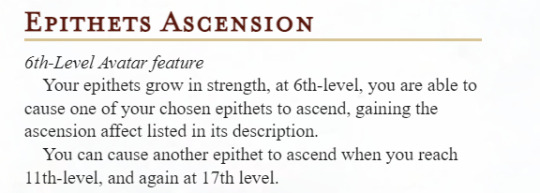
The idea behind it is that if you have an epithet you really enjoy using, you can have it ascend and cause it to become stronger. It's also meant to help keep the epithets viable as you gain levels in this class, an example of this is the Mighty epithet, where if you cause it to ascend, as shown here:
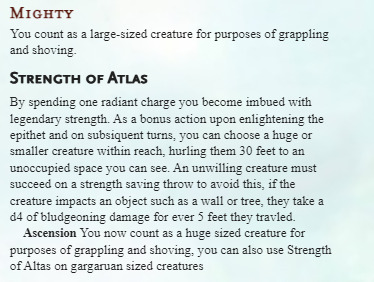
Holy hell, I am so sorry for taking this long on the series. I got caught up with other projects + reworking the avatar itself, so this ended up being put on the backburner until now. Hopefully I can get the next entry: Subclasses out in a timely manner, but we shall see.
But that's all I have for today, make sure to like + share my content if you enjoy, have a nice day, go out and make some homebrew.
Homebrew Class design For Dummies: Part 1: The Foundation
Homebrew Class design For Dummies: Part 2: Getting Started
Homebrew Class design For Dummies: Part 3: Finishing the base class
Guide to Balancing Classes
#dnd homebrew#5e homebrew#dnd#dnd5e#homebrew 5e#5e#dnd 5e homebrew#dungeons and dragons#dungeons and dragons homebrew
46 notes
·
View notes
Text
Updates and Things
Hey there~! I just wanted to hop on here real quick since this account has gotten more attention than I anticipated the last couple of days.
I appreciate the support ya'll have given this account, I really do, and I hope I can provide succinct enough content to keep ya'll interested.
With that being said, I want to provide a slight roadmap for things I wanna get done
The Avatar/Homebrew Class Design for dummies
If you've been keeping up with my "Homebrew Class for Dummies" series of write ups, then you know i'm working on a martial class inspired by Hercules, Monkey king, Maui and alike. The progress on that class is going well at the moment, right now I plan to post the class on October 20th at the very least. I hit a bit of a brick wall with the subclasses, but in the end, I hope you will enjoy what the avatar brings. Personally I'm enjoying what I have laid out for the class, and I hope you'll enjoy this most legendary of martials. Also included in the document will be some feats to give your martial characters some extra oomf. Cause I like giving myself more work
Along with this, Homebrew Class Design for Dummies should hopefully conclude around the same time, the last couple entries I have planed include class resources/mechanics, subclasses, and maybe an additional one about criticism/playtesting.
Festive Content
When I get those two done, I also plan on creating compendiums of content for the festive season, right now I have a bundle of halloween-themed content for your D&D sessions planned, I also plan on making a bundle for christmas time as well, so you can feel holly and jolly as you slash down goblins and dragons alike.
Other Things
I have a few other projects planned in the backburner as well, off the top of my head some I have include
A revised version of my Warlock Reborn.
Finally releasing that Hemothurge class I've had on the backburner
A bender class, inspired by Avatar: The Last Airbender
A take on the Warden class from 4th-Edition
I hope you'll stick around for whatever the future brings for this account. But until then, stay awesome, go out and play some D&D
0 notes
Text
Homebrew Class design For Dummies: Part 3: Finishing the base class
Hi there~! Welcome to the third edition of homebrew class design for dummies, where I teach you how to make a homebrewed class for D&D fifth-edition, in case you missed part 1 and part 2, we went over both the initial planning that goes into making a homebrew class, as well as the first three levels, this entry will be about finishing the base class.
Quick recap
Some advice from the previous entries bares repeating here as they come much more into affect
Number of features: By this point classes get 1 feature per level, though you may give a second feature at and given level either just as a ribbon or cause it's getting a "weak" feature at that level.
Dead levels: Dead levels really go into affect in these later levels, they particularly come into affect for full/half casters when they get their higher leveled spells. Martials generally don't get dead levels, and if they do it's cause an existing ability gets improved (Ex: Brutal critical and Fighters second action surge)
The Tiers of Play
While this warranted inclusion in the previous entries, it is worth mentioning that 5e features "Tiers of play" as their called on page 16 of the PHB. To pull some wording from it: 1-4th level (Covered in the previous entry) are the start of your character adventuring career, when they're still figuring out their abilities and what they can do. 5-10 is when your characters start to come into their own, 11th-16th level adventurers are essentially in the "Big leagues" 11th-12th level are also typically when adventures end with some exceptions, and 17th-20th level are the endgame, where your character has reached mythic status.
This write up focuses on the later tiers of play, remember that, while the abilities given at levels 1-3 are meant to set your class up for the rest of the game, the later levels are meant to both expand on the class, but also gradually increase their power until their capstone.
Key Features
Also of note are certain features that pop up post level 3 that should be kept in mind while designing your class.
Ability score improvements: Each class (with the exception of Fighter and Rogue) get an ability score/feat at 4th, 8th, 12th, 16th and 19th level. These levels are big enough for a characters career that you should avoid giving class features at this levels.
Extra attack: At 5th-level martials and half casters (with the exception of non-armorer or battlesmith Artificers) get an extra attack, meant to help keep up in power for the rest of their career, depending on what you envision for your class, they may get an extra attack at this level, or they may have an altered version of extra attack, an immediate example that comes to mind is Kibblestastys Warlord, their version of extra attack allows them to use their battlefield presence feature twice instead of just once, maybe you can borrow language from the bladesinger and allow your class to use an ability in place of an attack, have fun with it!
Capstone: At 20th-level, a class gains their capstone ability, the absolute peak of their power, feel free to go a little crazy with these. Sure most won't be able to experience their classes 20th-level ability, but throw a bone for those that do.
As a quick note, when making your capstone, make sure to avoid giving your class features like superior inspiration or perfect self, those types of features that read "When you roll initiative you regain one "" point" they never feel good or worthwhile as capstone features. If you wanna be extra special, you can take some cues from the paladin, who has a unique capstone depending on their subclass, it's not the norm but it could be fun to experiment with. Especially if your class is extrinsically tied to your subclass.
Summary
To summarize the points made within this (Admittedly short) write up, when finishing the rest of your homebrew class you should:
Respect Dead levels and "Common" features and why they exist
Come up with thematic and gradually stronger options
Make a capstone that'd entice players to stick through to 20th-level, rather than multiclassing as fast as they can.
The Avatar
Last but not least, taking in all of the advice given within this write-up into consideration, here is what i've come up with for the Avatars 4th-level and beyond.

5th-level is the standard extra attack for any martial, 6th-level is an improvement to your exceptional figure feature, making you immune to disease and allows you to add your charisma modifier to your strength checks.
9th-level grants you fortune and glory, allow you to use a radiance (Formerly known as conduit dice) to reroll a saving throw you or an ally makes (Cause you know, support) the 10th-level improvement to exceptional figure grants you resistance to radiant or necrotic damage, and you recover 1 point of exhaustion upon completing a short rest (Carried from the Rangers Tireless feature) Blazing eulogy allows you to instantly activate an epithet upon rolling initiative, so long as it doesn't impose a saving throw upon activation. My idea with the feature is to allow the avatar to get a buffing epithet up and ready without sacrificing their bonus action round one, I imagine this feature is particularly nice for polearm or crossbow wielding Avatars.
13th level grants you peerless reputation and Exempalary blows, the first of which grants advantage on charisma checks in towns you've spent a day in while Exempalary blows allows you to roll an additional damage dice the first time you deal damage, just a extra little boost to help them keep up in the higher tiers of play. Mythic resolve grants advantage on death saving throws, and when you roll a natural 20, you gain hit points equal to your avatar level. It's meant to represent this anime like moment where you're at deaths door, hope seems lost, but then you roll that natural 20 and become filled with newfound vigor. Sure maybe it isn't much for a 14th-level feature mechanically speaking, but I just love the flavor, it feels super fitting for what I'm trying to accomplish with the avatar (On a thematic level.)
Unbreakable will allows you to succeed on a saving throw once per day, essentially granting you a legendary resistance, which felt so thematically fitting for this mythical/folk-hero inspired class. And lastly, Absolute Divinity allows you to regain one radiance dice when you start your turn without any, you also cannot age but you know, that's just a flavor thing. You don't get a traditional capstone because that is determined by your subclass. A bit of me just likes the thematic of your subclass, the source of your power granting you abilities at the start and end of your avatars journey.
That's all I got for this write up. I apologize that this one took so long to get out, got caught up with things and also hit a roadblock when designing the avatar. Tune in next time where we cover class resources, in the meantime. Stay awesome, go out and make some homebrew.
Homebrew Class design For Dummies: Part 1: The Foundation
Homebrew Class design For Dummies: Part 2: Getting Started
Guide to Balancing Classes
#dnd homebrew#5e homebrew#dnd#dnd5e#homebrew 5e#5e#dungeons and dragons#dnd 5e homebrew#dungeons and dragons homebrew
39 notes
·
View notes
Text
Hi there
Sorry homebrew class for dummies is taking as long as it is, not only have I gotten caught up with other things. I've also had a tough time designing the remaning avatar clas features. By this Friday it should be completed, so stay tuned for that.
0 notes
Text
Homebrew Class design For Dummies: Part 2: Getting Started
Hi there~! Welcome to the second edition of homebrew class design for dummies, in case you haven't seen the first part of this. Welcome! This is a series of blogs where I go over how to make-what else, a homebrew class for Dungeons and Dragons Fifth-Edition. The previous post discussed the "planning" phase, going over the classes role in and out-of combat, their area and other minutia. This entry will cover the level 1-3 foundation, along with some other design concepts to help your class get off the grounds into becoming something amazing.
But First!
Before we get into making our class, there are a few key ideas you should keep in mind when designing a character option for 5e, some of this ties back into advice given in part 1, but bear repeating here.
Very basics
These things don't require much of an explanation, but just things to well...Keep in mind
Strong and weak saves: Each class has a strong (Constitution, Dexterity and Wisdom) and weak saving throw (Charisma, Intelligence and Strength) make sure to give one of each to your class.
Ribbon features: Ribbon features are like seasoning, while not adding much to the fully course, they enhance the classes flavor, a bad example of a ribbon feature is "Druidic" simply put unless your DM actively gives you a use for it, it is a completely useless feature. So make sure you're ribbon features actually come into affect when roleplaying the class.
Amount of features: Typically classes gain 2 features at these early levels, the only exception of which is paladin at 2nd level, though that's probably due to how divine smite works off your spell slots, unless you're gonna give a ribbon feature at one of those levels, it's best not to give three class features at once.
Dead levels: Dead levels are those levels where you get nothing, nada, bupkis. Spellcasters have the most dead levels due to them getting cantrip enhancements + higher level spells as they level up, use them where appropriate.
Bounded Accuracy:
In laments terms, bounded accuracy is meant to keep DC's around a bounds the designer intends for (In 5e's case 0-30) this is why, not including magical items or feature such as the barbarians capstone, this applies to whether you're attempting to break down a door or stabbing a vampire. Bounded accuracy is also accompanied by 5e's horizontal progression system, meaning that rather than your numbers going up, you gain more features to make you better at certain tasks (Damage, healing, etc) rather than bonuses to hit, to damage, etc and such, there are some exceptions (Advantage, Bless) but
Keep an eye on these
Weather you're designing a spell, subclass or a new class in our case, there are a few things in game that you should keep in mind
Barbarian Rage
Bards Magical Secrets
Druids Wild Shape
Fighters Action Surge
Monks Stunning Strike
Paladins Divine Smite + Auras
Rogues Sneak attack
Sorccerers Metamagic (Quicken + Twinned spell)
Warlocks Eldritch Blast and Pact Magic
Wizards Spell Mastery
All of these features not only serve as foundations for their respective classes, but also grant the class a huge deal of power. And in a game where 5e's multiclassing system is a thing, keeping these features in mind is helpful, for an example, say your class allows you to easily get off weapon attacks as a reaction, which, while possibly mediocre on its lonesome can get out of hand when paired with a rouge multiclass, due to how sneak attack can trigger multiple times if using a reaction attack (Since it triggers once per turn, rather than once per round) it's fine if you want to have interesting synergies between classes, just make sure you don't break anything in doing so.
While not class features, some other character options also grant players with them a great deal of power by virtue of their existence.
Feats: Sharpshooter and Great Weapon Master
Spells: Aid, Booming/Green Flame Blade, Counterspell, Conjure animals/Woodland Beings, Pass without trace, Wish.
Laying the foundation
With all of that jargon out of the way, lets begin laying out the first three levels of a homebrew class.
Level 1:
Level 1 is effectively the rookie stage of your classes career, whether they trained at a mystical academy or bonded with sewer rats, the first level of your given class should lay the framework for your class going forward, to give some examples, barbarians at 1st-level are given rage as their core feature, alongside a complementary feature in unarmored movement, rogues get sneak attack and expertise, fleshing out their role as a sneaky skill-monkey archetype. spellcasters (Besides the paladin and ranger) also get their spellcasting at this level.
Level 2:
Level 2 is where your character is starting to get a grasp of their abilities, similar to level 1 many classes get some of their most defining features here at this level, such as Druids Wildshape, Rogues Cunning Action, Clerics Channel Divinity, the list goes on.
Level 3:
Level 3 is where your character has gotten the grasp of their abilities and now can truly be one of their own, this is where the fullcasters get their second levels spells and where the martials get their subclass of choice, speaking of subclasses:
Where do I put the subclass?
A likely question you'll have have when making your subclass is "Where do I put it" or "What level should they get it, while non of what i'll state is definitive, some general guidelines for 1-3rd level goes as follows:
A subclass at 1st-level is generally done because it is absolutely crucial to the classes fantasy, say for instance your class is about you harnessing a curse (Ex: Ross leisers accursed) getting your subclass at first level would make the most sense, to use base game classes as an example sorccerers, warlocks and clerics get their subclass at 1st-level because said subclass defines the source of their magic (their core feature). Despite what OND DND might say, it would be weird for you to be a abberant mind sorccerer, born from the forbidden alliance of a githyanki and mind flayer, but not able to do anything psychic or eldritch until two levels later. While many tables may skip over 1st-level (especially much older groups) you shouldn't neglect that oh so precious first level.
A subclass at 2nd-level , while only used for two classes (Being wizard and druid) its done due to 3rd-level is a massive spike in power for any full caster, as you're given your second level spelld at that level (with rhe exception of bard)
A subclass at 3rd-level is typical of many martial and half casters, this is best used if your subclass describes which type of said class you are, for instance, fighter and rogue subclasses detail what kind of fighting man, or what kind of theif you are, essentially making the first two levels a "training period" of sorts.
Subclass Progression
Last thing in relation to subclass, while you can simply use the wizard, fighter or paladin subclass structure for your subclass, feel free to go out of the box (Within reason) with it, want your class to gain its final subclass feature at 20th level? Go ahead! Just keep in mind that subclasses only give you 4-5 features maximum. You can do more, but that'll likely mean your base class takes a hit in power as a result.
The Avatar
Now for the moment you've (Maybe) been waiting for, using the knowledge bestowed within this article I shall showcase the first three levels of the Avatar class.
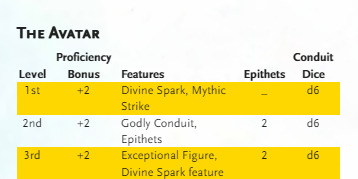
Divine Spark is your avatars subclass, determining the source of your divinity, similar to a cleric divine domain. While I haven't written down any features of their subclasses quite yet, I have four planned for the class so far (With more likely on the horizon) You also gain the Legendary strike ability, which not only increases your weapons damage dice by one, you also give temp hp to your allies when you score a critical hit.
Godly Conduit acts similarly to ki on the monk, you gain a number of conduit dice equal to half of your avatar level + your charisma modifier, which you can use to either leap a number of feet equal to 5 times the number rolled, or gain an expanded hit range with your weapons for a number of rounds equal to the number rolled. My favorite feature so far is the epithets, which are described bellow:
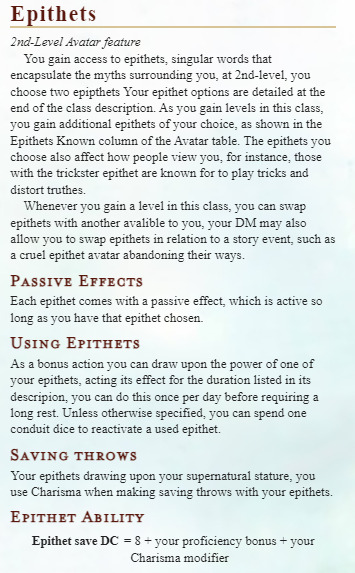
I cannot wait to show off the epithets sometime in the future. I am super proud of how they're turning out as of now. My hope is that they not only allow for a customizable avatar, but also help redefine how you utilize weapons.
at 3rd-level you gain a ribbon feature, exceptional figure, which makes it so that you cannot suffer disadvantage on any strength-based ability checks you make. Alongside that, feasting now counts as light activity for you and your allies while resting, meant to emulate the giant appetite many heroes of myth have, and I love the idea of an avatar and their allies after a long fought battle just pigging out to their hearts content.

You also gain another subclass feature at 3rd-level to for one last power spike in the starting levels.
Summary
To summarize everything covered within this entry, when laying the 1-3rd level foundation for your subclass, you should
Keep the basic rules of design in mind.
Create features that lay out what you want your class to be doing.
Give them a cool roleplay feature to help with your classes theme.
Determine where your classes subclass should go.
Get to Writing.
That's about all I got for this entry, next time we will go over features after 3rd level, going from 5th to 20th level, make sure to follow me if you're interested in that but until then. Thank you for reading, stay cool and go make some homebrew
Homebrew Class design For Dummies: Part 1:
Indestructoboys Homebrew Design Masterclass
Where to put my subclass by Indestructoboy
Two videos on Bounded Accuracy: 1 2
#dnd homebrew#dnd5e#5e homebrew#dnd#homebrew 5e#5e#dnd 5e homebrew#dungeons and dragons#dungeons and dragons homebrew#writing#writting tips
32 notes
·
View notes
Text
Hi, hope you don't mind me giving some feedback regarding the vessel, I would've made a comment about it but i'd rather go more in depth with it.
Positives
The class is brimming with flavor, all of the abilities it and its subclasses give are very thematic for what they want to do. In particular I enjoy the synergies and the sublime power feature. The use of exhaustion is also pretty interesting (And frankly handled much better than the berserker barbarian) I'm also glad you addressed exhaustion. Though I have some issues in relation to the subclasses they (For the most part) seem relatively balanced? especially given how many more options they have due to their unique synergies, which I also enjoy.
Issues
I think the classes 1st-level can be greatly expanded upon, since currently you only receive a ribbon feature + unarmored defense, given the thematic of the vessel I think you could get away with having your subclass at 1st-level, that'd likely require some reorganization of abilities but It'd make the vessel smoother to play in those early levels.
Onto the synergies, I find it odd how over Powerful form says you gain expertise in athletics if you already have it, but Overwhelming Aura uses the more typical "you may add double your proficiency bonus" wording. Supernatural evasion is pretty potent with you adding your PB to your AC when you take the dodge action, on top of having disadvantage on attacks made against you, even just a +1 or 2 is fine enough for those situations where you'd need to dodge. Same goes for Debilitate (Though that could be reworked into having them subtract a d6 instead)
Onto the subclasses, the primordial beast's burrowing ability should include text about leaving a tunnel behind you, since most creature don't have a way to deal with you while underground, and it's not unreasonable to assume someone might use it to pop up, smack someone in the face, then burrow back down to stay safe. I also think this line from the unbreakable synergy could use some clarification "You can not be killed by massive damage."
A lot of the text in the "Field training" feature of the destroyer can be cleaned up a little, for example, instead of saying "You gain proficiency in light armor, medium armor, heavy armor, and shields." instead can read as "You gain proficiency in all types of armor and shields." The PB to initiative is also very potent and is probably best pushed back to a later level, advanced critical is ungodly powerful for what it is, I am aware crits have a 5% chance to hit, but up to a -6 to hit is rather absurd, it's also just not something done in 5e due to bounded accuracy and such, I think it could be reworked into giving advantage on your next attack against them, or replacing it with the frightening feature given at 11th-level.
Overall, I enjoy what you've done with the class, I hope I didn't come across as harsh, I hope to see the class be refined and polished in the near future.

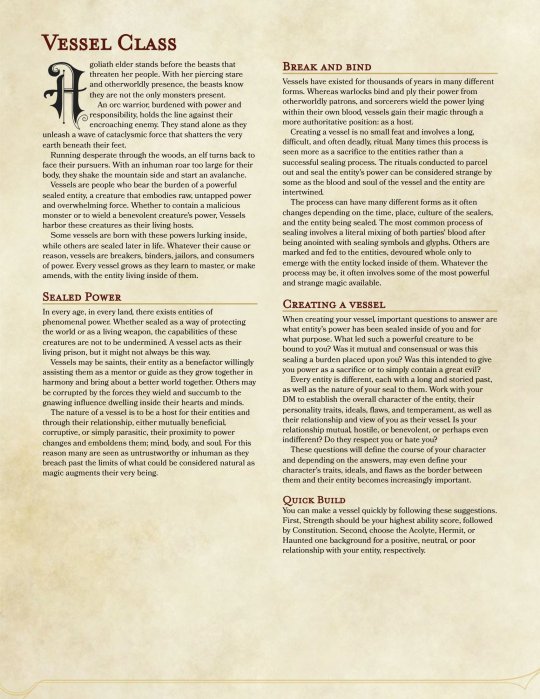

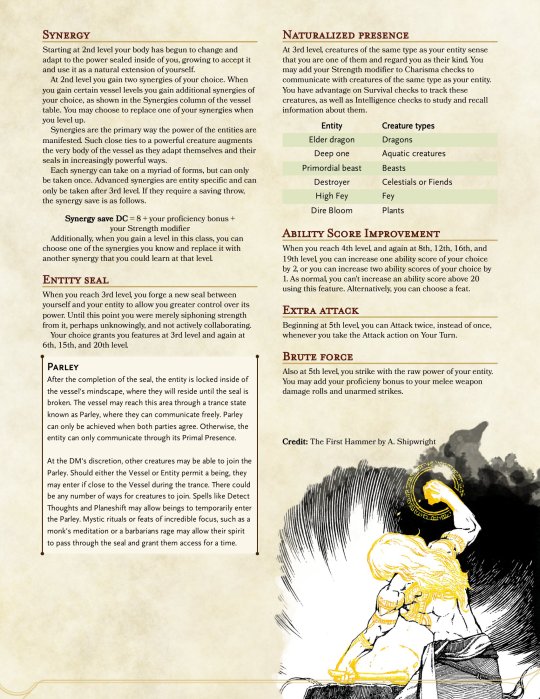







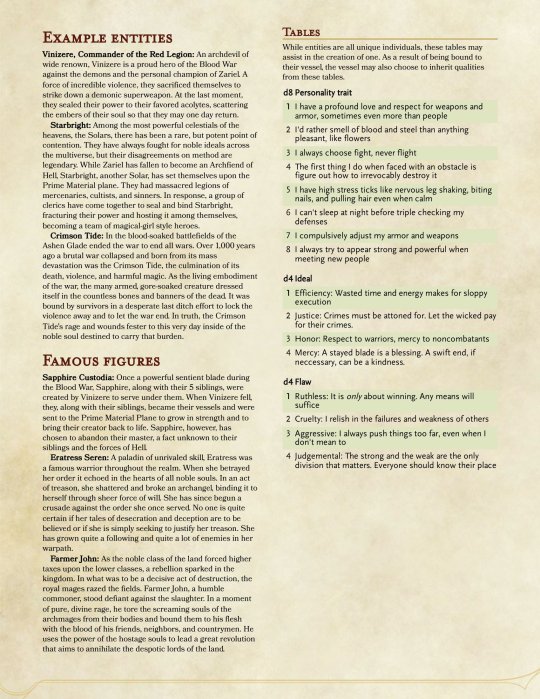
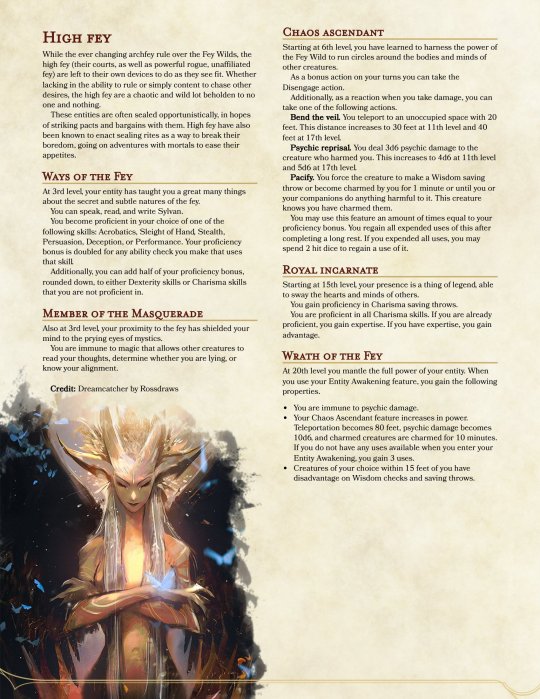


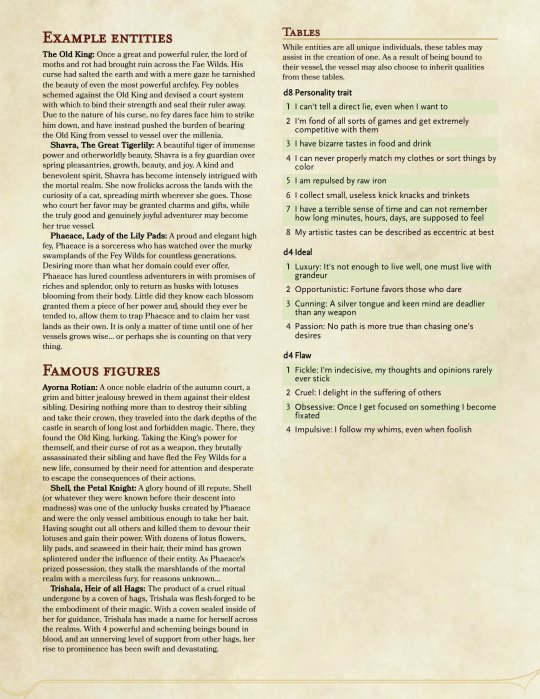




Introducing the Vessel class version 2.2!
It's been a long time for all of us, hasn't it? About 2 years ago this project started and now, slowly and surely, it closes in on its fully realized state
I already posted up the original subclasses: elder dragon, deep one, and primordial beast for all of your draconic, sea monster, and fuck off huge animal needs
Aaaand here we are with the 2nd batch!
The Destroyer, for ascended demons and rampaging angels
The High Fey, for the various tricksters of the Fey Wilds
The Dire Bloom, for supernaturally powerful flowers, trees, and what have you
As always I simply must thank my friend PJ, my collaborator, tester, and DM
My gf, who helped spark the Vessel class and plays the first ever vessel, Nia Rivers
And a special thank you to my dear friend Rowan who I lost very recently. The act of creating will save you. <3
As always you can find the full homebrewery document here: https://homebrewery.naturalcrit.com/share/n_swReh_PBe6
481 notes
·
View notes
Text
Homebrew Spotlight: The Warden
Hi there~! While you wait for my next entry into homebrew design class for dummies, I wanted to give some spotlight to one of my favorite homebrew designs as of writing: The Warden by Kibblestasty

Based on 4e's class of the same name: The Warden is a class that focuses on locking down targets and tanking
When you don light or medium armor, you can enhance it
with mystical defenses, integrating it with manifestations of
your Warden Bond (for example, an Elemental Soul may
manifest icy plating to reinforce it). When you do so, you can
use your Wisdom modifier in place of your Dexterity modifier
when calculating your AC with that armor.
While you have your armor integrated with your primal
power, when you take bludgeoning, piercing, or slashing
damage, you can reduce the damage taken by 2. This value
increases at 5th level (to 3), 9th level (to 4), and 13th level (to
5), and 17th level (to 6)
First, I love the flavor text at the start mentioning how an elemental soul may manifest this feature, but I also like how it immediately establishes your role as a tank, it helps keep your AC up when you otherwise would be lacking, helps reduce the MAD (Multiple-Ability score dependency) of the class, but also reduces damage taken by a flat amount, similar to a barbarians rage.
Moving on to second level the Warden is granted two features, Primal Interdiction and Endurance Die, the latter allows you to roll a d8, using it to either reducing oncoming damage or adding it to a saving throw, the die and uses increase as you level up. Primal interdiction meanwhile reads as follows
Nature hinders your foes with aspects of your primal power. This effect has a 5 foot radius centered on you, turning the ground within range into difficult terrain for creatures of your choice. Additionally, at the end of your turn, you can choose to recklessly defend your allies within this area at the cost of your own safety, giving attacks against you advantage, and giving attacks against allies within the effect disadvantage if you are also in range of the attack being made (or have been at any point since the start of the attacker's turn) and not behind total cover. The range of this effect increases by 5 feet at 5th level (to 10 feet), and again at 11th level (to 15 feet), and 17th level (to 20 feet).
This feature is what really establishes the warden, not only do you establishing yourself as a battlefield controller but you also gain a defensive version of reckless attack. And I simply love it, at 3rd-level you gain Primal Manifestations, which essentially act like eldritch invocations, either granting you a tiny boon or allowing you to cast a specific spell. You also gain the gardens grasp feature, which lets you grapple a target when you make an opportunity attack. While I recommend you read the whole document, the basic rundown of its remaining class features include:
Your natural weapons overcome resistance to nonmagical attacks and damage
You add your con modifier to damage reduced via an endurance die
You no longer need to eat or drink and are immune to disease
Your Mystic bulwark works on all damage types
You can bring yourself back to 1 hit point when you fall to 0.
You gain a swimming speed or a burrowing speed
And as your capstone, you can essentially warp the area around yourself, causing an effect similar to earthquake or manipulate weather
Got all of that? Good, now lets move onto a basic rundown of the subclasses, also known as your Wardens Bonds
Elemental Souls can create weapons of the elements, such as lightning lashes or a shield of ice, create an elemental maelstrom within their Primal Interdiction, and transform into embodiment's of the elements.
Beasthides can sprout claws, gain bonuses to grappling and athletics checks, cause their claws to crit on 19 or 20, cause concentration on their inate spells to be unbreakable via damage, and transform into a gigantic form.
Elderhearts create lashing vines, redirect damage back to their attackers, turn critical hits against them into normal hits, transform into a treant-like form and sprout trees.
Stonebloods create fists of stone (Duh) that they can augment with different properties, unleash tremors, pull in enemies, gain tremorsense and draw upon the power of the earth itself.
Sunwatchers (My personal favorite at the moment) create blasts of solar energy, use the light cantrip to augment their weapons, create solar flares, teleport in a burst of sunlight, and transform into an embodiment of the sun itself.
And lastly: Ironbounds can use their Mystic Bulwark with heavy armor, gain resistance via Endurance Dice, use chains to bind those that attempt to escape your primal interdiction, morph and adapt sets of heavy armor, and transform into a monolith of iron.
There's not a whole lot to cover in terms of the primal manifestations, but in essence they're little bumps that enhance your endurance die, enhance your weapons and create various walls to impede your foes.
Final Verdict
Overall I really enjoy what kibbles has done with the class, I love its blend of tanky endurance coupled with battlefield control, an archetype not present on martial classes outside of subclasses I also enjoy how it allows you to to use magical abilities, in particular I like how the subclass specific spells allow you to use your Endurance Dice to cast them. I also admitively am a sucker for magical martial classes if you couldn't tell.
If you like what you've read then make sure to check out kibbles other content, and if you feel so abridged make sure to donate to him as well.
That's all I got for today, if you want me to cover any other homebrew classes, subclasses or likewise let me know, links to the warden + Kibbles website is down bellow, stay cool and go make some homebrew.
The Warden
Kibblestasty's website
#dnd homebrew#5e homebrew#dnd5e#dnd#homebrew 5e#5e#dnd 5e homebrew#dungeons and dragons#dungeons and dragons homebrew
0 notes
Text
Warlock reborn update
Hey there~! Since i'm getting newer followers and such I just wanted to make a quick post regarding projects
I will still be working on things such as the Hemothurge, Avatar and the Homebrew class for dummies, but I wanted to make a quick announcement here. I am planning on reworking the warlock reborn, while I appreciate the attention it is still getting, honestly I don't like the state that it's in, sure I like most of the ideas presented, I simply feel like now with a better mindset (Not to mention the lastest UA including Warlock) I could do a much better job with the class now.
I won't give away all of the details, but I hope you'll enjoy a much more refined and well put together version of it. That's all I got for the moment, I bid you farewell from the garden. Stay cool and make some homebrew.
1 note
·
View note
Text
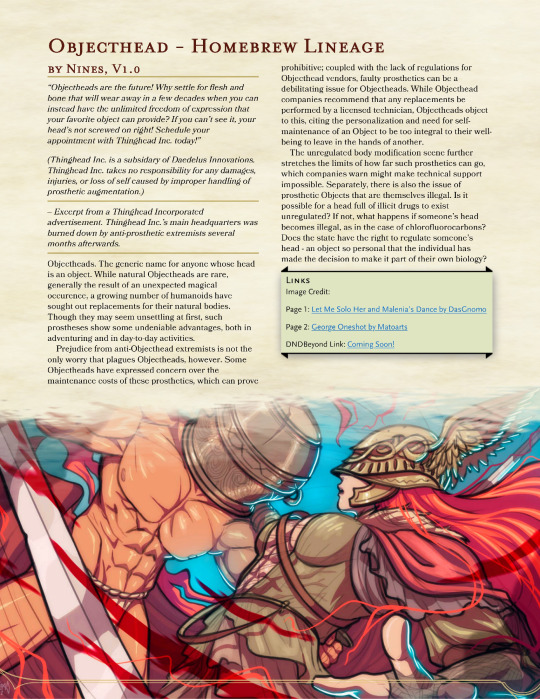
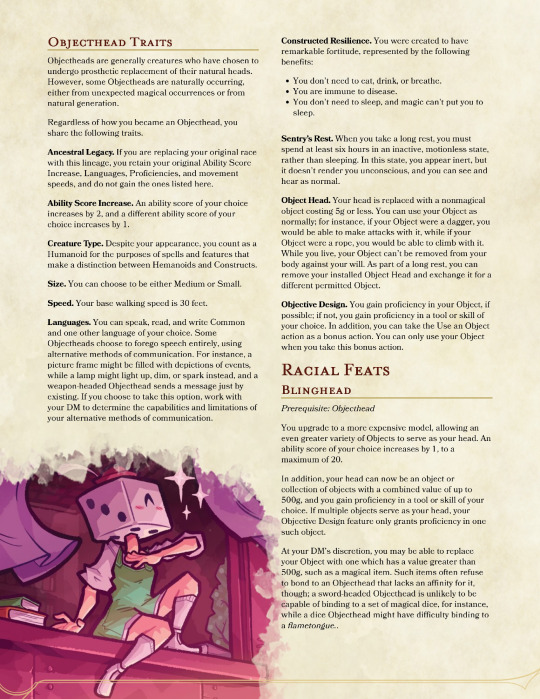
Objecthead - Homebrew Lineage by Nines, v1.0
Heads will roll... the dice.
Objectheads, as the name implies, have an object for a head. While this allows them to transcend many physical limitations, such as the need for food and sleep, they still need to keep their head on to survive - so maybe don't try replacing your head with a Revivify diamond.
234 notes
·
View notes
Text

Subclasseptember Day 7: Fey
The College of Jest - Homebrew Bard Subclass
When I made the Subclasseptember list for this year (with permission from @nite0304, who made last year's), I wanted to ensure that each entry had multiple potential avenues to explore. For instance, Fey here can refer to fairies, as it is often used in D&D - but it can also refer to more general childness, a happy disposition, or the Scottish definition of "at the point of death."
From everyone else's expressions, it's clear that the Jester here has just told an incredible joke.
#subclasseptember#homebrew subclass#subclass#dnd homebrew#subclass homebrew#5e homebrew#dnd 5e homebrew#dnd
168 notes
·
View notes
Text
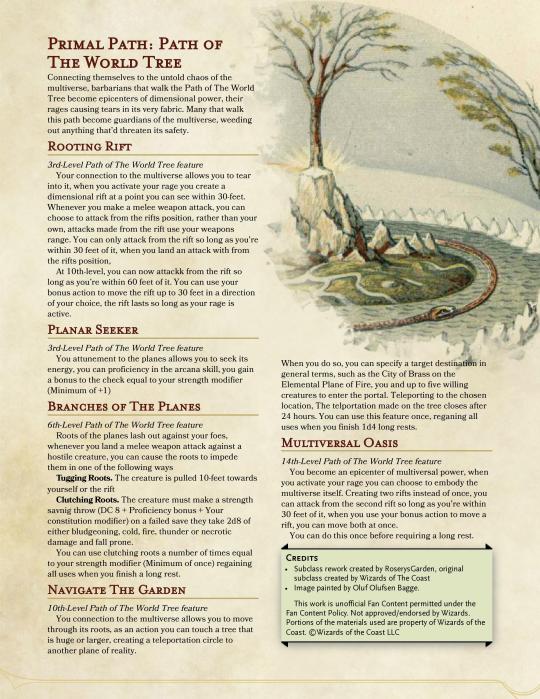
Hi there~! So If you haven't heard, Wotc has put out another unearthed arcana for One DND, 5.5, whatever its being called. In it came two new subclasses. The Brawler Fighter and The Path of The World Tree Barbarian, both of which I am not a fan of, but the world tree barbarian struck a nerve for me in particular cause it feels like WOTC has no idea what the subclass is supposed to be. So lets go over it
Vitality of the Roots is all the world tree barbarian gets at 3rd-level, it reads:
When you activate your Rage, you regain a number of Hit Points equal to your Barbarian level. At the start of each of your turns while your Rage is active, you can choose another creature within 10 feet of yourself to gain Temporary Hit Points. To determine the number of Temporary Hit Points, roll a number of d6s equal to your Rage Damage bonus, and add them together. If any of these Temporary Hit Points remain when your Rage ends, they vanish.
Okay cool, this is going to be a support barbarian, that isn't really a thing outside of maybe storm herald, cool feature right? Well let's get into the next feature, Branches of the Tree:
While your Rage is active, whenever a creature you can see ends its turn within 20 feet of you, you can use your Reaction to summon spectral branches of the World Tree around it. The target must succeed on a Strength saving throw (DC equal to 8 + your Proficiency Bonus + your Strength modifier) or be teleported to an unoccupied space you can see within 5 feet of yourself or in the nearest unoccupied space you can see. The space the target teleports to must be on a surface or liquid that can support it; otherwise, the target doesn’t teleport.
Now we're a controller style barbarian? The features alright but idk, it feels weird going from healing to control, lets check the next ability, Battering Roots:
Tendrils of the World Tree extend from your melee weapons. While you wield any melee weapon, your reach with that weapon increases by 10 feet, and when you hit with it, you can activate the Push or Topple property even if you’re using another Mastery property with that weapon
In case you forgot, the push property allows you to well, push enemies, and topple allows you to knock people prone, it's alright-if not particularly synergistic with the previous feature, but maybe they can bring it back with the capstone. Travel through the Tree:
As an action, you touch a Huge or larger tree or a Teleportation Circle to create a link through the World Tree to a Teleportation Circle somewhere else on the same world or on another plane of existence. When you do so, you can specify a target destination in general terms, such as the City of Brass on the Elemental Plane of Fire, and you and up to five willing creatures within 30 feet of you appear at the Teleportation Circle closest to that destination. If a Teleportation Circle is too small to hold all the creatures you transported, they appear in the unoccupied spaces closest to the circle.
Once you use this feature, you can’t use it again until you finish a Long Rest. If you’ve run out of uses of this feature, you can expend five uses of your Rage, choosing to activate this feature
instead of Rage.
Yeah, the capstone is basically a ribbon feature. I guess it'd be really good if you're playing in a multiversal campaign but otherwise, this feels really bad as a capstone. Like you go through the effort of getting your barbarian up to 14th-level (Btw, most campaigns at most go to 10-11th level, even WOTC's own adventures do this) just to use teleportation circle. Overall, while I love the idea of a controller barbarian (Especially since most barb subclasses focus on enhancing existing barbarian things, mainly tanking and striking) but the world tree barbarian just feels like a weird mess. So I decided to make my own version.
My version of the world tree barbarian is now focused around creating rifts in reality, which act as alternative positions the barbarian can attack from, say you have a band of goblins that are 30 feet away from you, but your rift is right next to them, you can choose to attack from the rifts position rather than your own, I choose to keep the pushing and pulling via Branches of the planes, the original capstone I converted into a 10th-level ribbon. And the capstone allows you to have two portals active at once, along with swapping places with existing rifts. Admitively i'm feeling a bit lukewarm on the subclass atm, but let me know if I did a good job, or if I made the worst subclass of all time.
That's about all I got for today, I might do more subclass reworks in the future so keep an eye out for that, for now I wish you farewell from the garden. Stay cool and make some homebrew.
#dnd homebrew#dnd5e#5e homebrew#dnd#5e#dnd 5e homebrew#dungeons and dragons#dungeons and dragons homebrew#homebrew 5e#dnd barbarian#barbarian
35 notes
·
View notes
Text
Homebrew Class design For Dummies: Part 1: The Foundation
Hey you~! Have you ever wanted to make a homebrew class for Dungeons and Dragons fifth-edition? Perhaps you wanted to recreate a character from a book or movie you like that can't be represented by a full/multiclass, maybe you want to recreate a class from older editions? Or maybe you just have a really strong concept in mind but struggle to put words to document, well have you come to the right place. This blog is meant to serve as a guide for those wishing to make their own class, starting from a simple concept to a finalized product.
This first part of the series will go over the conception of a homebrew class, talking about the concept, role and other relating topics. Over the course of this series you'll also see the live development of a homebrew class "The Avatar" inspired by Hercules and Maui, the avatars are warriors that wield the powers of god, empowered by the legends that surround them.
When making a homebrew class, the first thing you should have in mind is a concept. Maybe you want to play a certain fantast archetype you want to play that isn't possible with existing content, maybe you have a mechanic in mind that wouldn't fit as a subclass feature, or you want to expand on more forgotten aspects of D&D like tattoo magic. Whatever your starting point may be, make sure to jot down other themes and ideas you want to present. Given the themes of the avatar I can already jot down some ideas
Martial Class
Customizable blessings from their legends
Likely charisma focused
Buffs via dealing damage
I will preface that, when making the concept for your class, keep these things in mind.
1 Can you make the same type of character with existing options (Not including reflavoring/reskinning) admittedly the avatar class concept could leans into themes touched-on divine soul and oath of glory, however I feel that the herculean archetype is flexible enough to warrant its own class.
Is my concept flexible enough to make subclasses? For instance, say you want to make a caster that steals its opponents powers, cool...But what do you do for subclasses? In this case the avatars sub classes-their divine exemplar can come from which god empowers them, one subclass for example could be the exemplar of light, the exemplar of war, exemplar of death, etc.
Okay so, got all of that concept stuff down? Good, now is time to get some gameplay details down, nothing concrete just yet, but rather basic ideas of how and where your class is fighting. Now would be the time to bust out a writing program, such as google docs, notes, or anything alike.
Class Role
Your classes role is what they do in combat, do they want to deal damage? Heal? Defend? While this might simplify each type of role I listed some examples bellow:
Brawler: Brawlers want to get up close and personal, dealing high single target damage. Most martial classes fall under this archetype, along with Hexblade Warlocks or College of Swords Bards.
Blaster: Blasters are similar to brawers in that they focus on dealing damage, unlike brawlers they focus their efforts to large groups-rather than a singular target, examples include Evocation Wizard and Light domain Cleric.
Buffers: Buffers focus on provided positive effects to enhance their teams performance, such as better dice rolls or increased damage.. Buffers include most Bards, Clerics and Druids.
Controller: Controllers focus on impeding their enemies, limiting their options or event preventing them from acting at all. Controllers include Druids, Monks (Via stunning strike) and Undead Warlocks.
Debuffer: Similar to controllers, the debuffer focuses on weakening their opponents, making them less effective.. Debuffers include College of Eloquence Bards and Divination Wizards.
Healer: Healers do exactly what their name implies, keeping their party at well healed and removing negative effects. Healers include Life domain Clerics, Celestial Warlocks and Way of Mercy Monks.
Skirmisher: Skirmishers focus on darting in and out of the frontlines, remaning mobile all the way: Skirmisher include Rogues, Monks and any character with the Mobile feat.
Tank: Tanks focus on drawing enemy fire away from their allies and towards themselves. Tanks include Armorer (Guardian) Artificers, Barbarian and Oath of Redemption Paladins.
Keep in mind that some classes can fill multiple of these rolls through subclasses, feats, etc. Cleric immediately comes to mind thanks to their varied spell list and all of the divine domains present to them. For our avatar class I think a mix of striker and buffer could be interesting, where your goal is to deal damage, but also help your allies deal more damage and stay in battle.
Area
Also referred to as a characters "zone" a characters preferred area is where they'll be hanging out in combat, this information is usually indicated by things such as hit die, proficiency, etc. The obvious example is barbarian, who with their d12 hit die and martial weapon proficiency are designed to be up in the thick of things, meanwhile a wizard with their measly d6 hit die and no armor proficiency are best set for the backline, sure there may be ways to alter your zone, but having a concrete "My character is best at this area" can help defining their role in combat.
For the avatar, I will settle on it having a d10 hit die, both cause I imagine a demigod archetype would be rather tanky, but also since I imagine the class largely staying in front lines of combat, with them potentially being able to do range combat similarly to a fighter.
Out of Combat Role
While D&D combat is fun (depending on who you ask) it is equally as important your class to think about your classes role out of combat, will they attempt to persuade the king to aid the party? Will they be lurking in the shadows, setting a deadly ambush? A classes out of combat roll is supported by particular ability scores, proficiency and even class abilities. Going back to barbarian, due to their strength focus and proficiency in athletics are going to be the teams brawn, rogues thanks to expertise and natural affinity for thieves tools are likely to scout out ahead, disarming traps. To give some more concrete examples of roles, the list includes:
Brawn: Brawns use their strength to break doors, push away obstacles and grapple. They use strength and prefer athletics, acrobatics and sometimes intimidation.
Brain: Brains are the thinking men, they use their mind to solve problems and decipher mysteries. Brains use intelligence and wisdom, preferring arcana, investigation, history, nature and religion.
Face: Probably the most infamous DnD archetype, the face uses honeyed words to help their team. Faces use charisma and wisdom and prefer deception, persuasion, performance, intimidation and insight.
Heart: The heart is like the party glue, their job is to keep everyone healed up and ready for the day ahead. Hearts prefer wisdom and charisma, preferring animal handing and medicine.
Scout: Scouts gather information and disarmed traps, laying the path for their team to follow and take advantage on. Scouts use dexterity and either wisdom or intelligence, preferring stealth, sleight of hand, investigation, perception and nature.
Keep in mind that a class can have multiple of these rolls present at once, just cause you're a paladin doesn't mean you always have to do the convincing. In our case the avatar will serve primarily as a brawn and face, it feels like a natural given the concept.
Summary
To summarize all of the points made within this write-up. When you start designing a homebrew class you should:
Start with a strong concept.
Jot down your initial ideas.
Think about your classes role in and out of combat, as well as their area of play.
Get to work.
Final Note
Before closing out this first part, I want to go over some terminology you might hear floating around that I want to clarify before moving on as they'll be referenced going foward.
A martial class refers to a class that doesn't have spellcasting as a core feature, while D&D's official martials are mostly nonmagical-warrior types. A martial class can still be magical in nature, so go nuts with it! They're really fun to make.
Full casters are classes that focus on casing spells (duh) full casters possess a certain number of spell slots to cast increasingly powerful spells. Warlock is the one outlier since they work on their own system (Being pact magic)
Half-Casters are a mix between the two, while they can only cast up to 5th-level spells, they make up for it with martial ability built into their base kit (fighting styles and extra attack) they're great fun I'll tell ya!
I'll also recommend two resources for class design, the first is Indestructoboys homebrew design masterclass series, where I get many of my concepts from, alongside the guide to balancing classes on the Unearthed Arcana subreddit, which provides a good framework for future entries into this. Otherwise if you've made it this far, thank you for reading, and I wish you good luck in your homebrew creation. Tune in next week where we begin to put mechanics to document, but until then, see you around.
D&D Homebrew Class Design Masterclass | Before 1st-Level
Guide to Balancing Classes
#dnd homebrew#dnd5e#5e homebrew#dnd#homebrew 5e#5e#dnd 5e homebrew#dungeons and dragons#dungeons and dragons homebrew#homebrew#homebrew class#writers on tumblr#advice
45 notes
·
View notes
Text
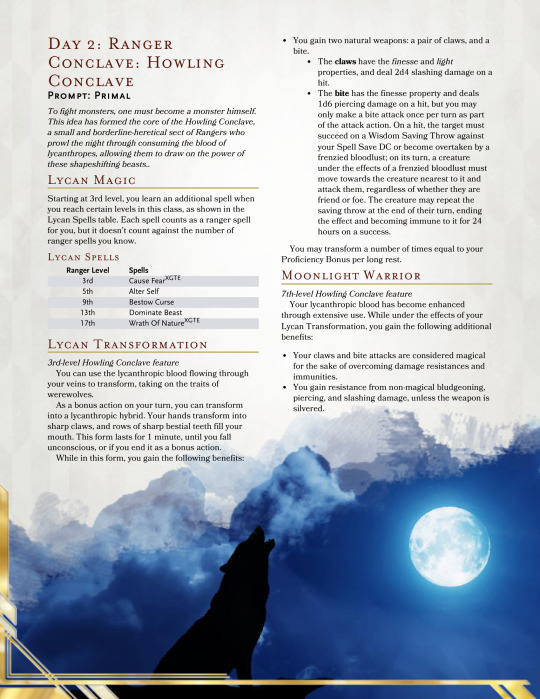

Subclasseptember 2023, Day 2 - The Howling Ranger
So for Day 2 the prompt was "primal". Initially my brain went towards having some kind of Barbarian-adjacent subclass, mixed with a fun little bit of werewolf for the monsterfuckers among you.
Core of the subclass is the Lycan Transformation, a kind of pseudo-rage in the vein of the Blood Hunter's Lycan form. I thought giving it some spicy natural weapons would be fun.
The Level 11 feature was basically there to fill space, but I'm happy with how it came out as either a buff or debuff.
The final feature is a bit of a diet Zealot Barbarian, in that they can essentially fight after death. But its on the whole a bit weaker, with a much greater risk of death actually happening.
90 notes
·
View notes
Text



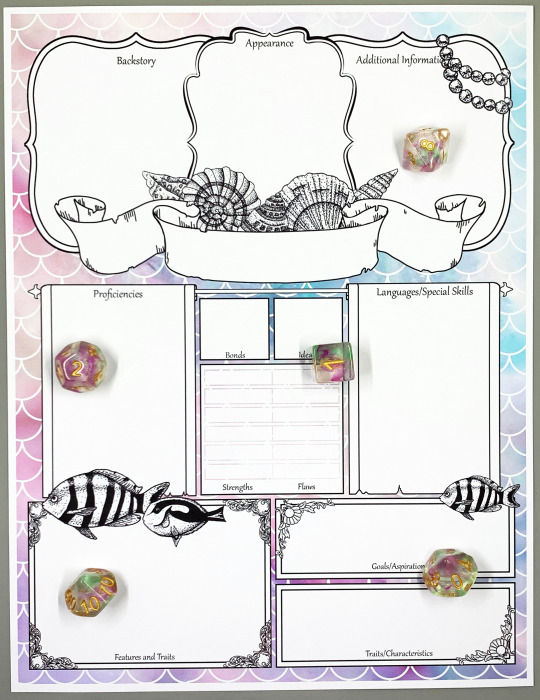

Be your best mermaid self, be your best mermaid character, be a mermaid, M E R M A I D dnd character sheets
You can find my work on Etsy! I make DnD and Pathfinder art (like character sheets) inkandclaw.etsy.com
46 notes
·
View notes